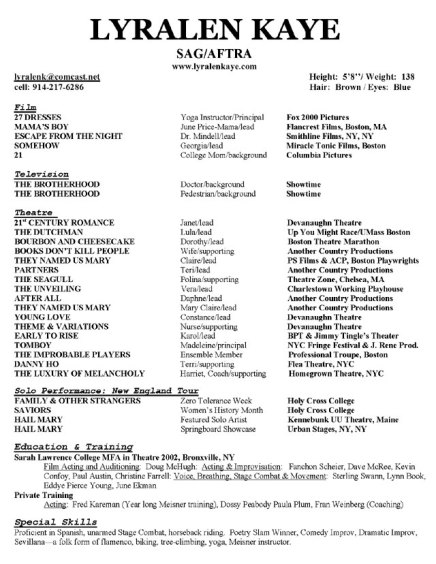All right folks, let’s get down to business [to defeat the Huns]. With intentions to go to college for a musical theatre education, I have several college auditions coming up. Also, the Lancaster Academy for the Performing Arts is holding auditions for their spring play, Pride & Prejudice, which my little brother and I both plan to be involved in. In preparation for this Jane Austen masterpiece, I am helping Phil (https://killerwink.wordpress.com/2011/04/06/55/) assemble a killer audition. We are required to prepare a monologue, a headshot, and a resumé. Personally, I find the first two easy in comparison to the third. The art of writing a good resumé, especially as a non-professional actor, takes some skill and a wealth of research. Unfortunately, the examples and instructions one finds online for writing a resumé are really only relevant for adults, and they’re quite vague. But fortunately, I have unwittingly picked up a ridiculous amount of knowledge on this subject by now. In dedication to all the other LAPA students who are frantically writing their resumés this weekend, I put together a specific guide for our unique demographic: The teenage thespian. I hope this is helpful to anyone who has questions!
GUIDE TO THE RESUMÉ FOR THE AVOCATIONAL/YOUNG ACTOR
1. Personal Info
- List your name in a way that can’t be missed – caps, bold, larger point or different but complementary font
- Your contact info: email address, phone number.
- Your personal info: Age, vocal range, hair and eye color, height and weight.
2. Experience
- Depending on how many shows/performances you’ve been in, you may need to be selective in which ones you include on your resumé.
- If you’ve done a lot of shows, pick your favorite/best (approx.) 6-10 to include. This may be based upon the importance of your role or upon the theater company with which you performed the show. If you’ve performed with several different theater companies, it is good to use shows from various companies on your resumé. Community or even professional theater experience, even as an ensemble member, looks great on a resumé.
- If you haven’t done any/many shows, that’s fine! If you have a different type of performance experience i.e. solos in choir concerts, film experience, church plays, etc., those are certainly things you can include. With a variety of performance types, it’s recommended to use different section headings for different media. For example, professional actors who work both on screen and on stage will have different sections of their resumé titled “Theatre” or “Film”.
- Organization is important. You want to call attention to your proudest accomplishments and make everything clearly legible for the director who has already read 45 resumés in the past two hours.
- To list your credits, make three columns to list the show (and sometimes year), your role, and the theatre/company (and sometimes director). This shouldn’t have lines like a table, but just look like a list. This organization is standard, but can prove difficult to use as some show/theatre names are long and use awkward line spacing. Play with spacing and/or understandable abbreviations to figure out how to make it look neat and professional as a whole.
- Make sure you list your credits in reverse chronological order with the most recent ones at top. This is one area of the resumé that is flexible, however; if you have a very impressive credit from a while ago, you could put that near the top rather than at the end.
3. Training
- Your training goes under another heading. This can include vocal, instrumental, dance, acting, or other training specialized for theater-related arts.
- Vocal/instrumental training can include private lessons, choir/orchestra, seminars/camps, etc.
- Dance and acting training can include classes, private coaching, seminars, etc.
- Actors who have had private coaches often simply list the names of their current and previous teachers (i.e. Acting: Stella Adler)
4. Special Skills
…is the final heading on a resumé. This list should not be twelve lines long, but can include a variety of skills in which you are exceptional. It can range from common skills (cockney accent, beginning piano skills) to more unusual skills (conversational German, Urdu, and Swahili; The Office impressions.) Don’t get carried away with this section, especially the unusual skills. It’s nice to have one or two eyebrow-raising skills listed, but keep your dignity. And only list things that you are genuinely great at and could actually do/prove on the spot for the director!
- Some great ideas of things to include are foreign languages spoken, dialects that you can do very convincingly, specific dance styles, backstage skills like sewing or landscape painting, and any other trick/skill you have that really impresses people.
General Tips
- Your resumé must be one page maximum! Don’t fill that page with ink, either. Make sure to leave white space on the page so it looks organized and not jumbled.
- Have uniform headings and hopefully the same or complementary fonts. Be consistent with your formatting.
- Resumé should be cut to a centered 8″ x 10″ and stapled in each corner to the back of your 8×10 headshot so the headshot/resumé combination is like a double-sided page.
- All info, especially contact, height, weight, hair/eye, and training should be the most current!
- Highlight what’s relevant for the particular show.
Best wishes to everyone auditioning this week! I know you’ll do great.
